


By Atsuko Kanazawa, Igor Houwat, Cynthia Donovan
This article is reposted with permission from the Michigan State University team. You can find the original post here: MSU-DOE Plant Research Laboratory
Atsuko Kanazawa is a plant scientist in the lab of David Kramer. Her main focus is on understanding the basics of photosynthesis, the process by which plants capture solar energy to generate our planet’s food supply.
This type of research has implications beyond academia, however, and the Kramer lab is using their knowledge, in addition to new technologies developed in their labs, to help farmers improve land management practices.
One component of the lab’s outreach efforts is its participation in the Legume Innovation Lab (LIL) at Michigan State University, a program which contributes to food security and economic growth in developing countries in Sub-Saharan Africa and Latin America.
Atsuko recently joined a contingent that attended a LIL conference in Burkina Faso to discuss legume management with scientists from West Africa, Central America, Haiti, and the US. The experience was an eye opener, to say the least.
To understand some of the challenges faced by farmers in Africa, take a look at this picture, Atsuko says.
“When we look at corn fields in the Midwest, the corn stalks grow uniformly and are usually about the same height,” Atsuko says. “As you can see in this photo from Burkina Faso, their growth is not even.”
“Soil scientists tell us that much farmland in Africa suffers from poor nutrient content. In fact, farmers sometimes rely on finding a spot of good growth where animals have happened to fertilize the soil.”
Even if local farmers understand their problems, they often find that the appropriate solutions are beyond their reach. For example, items like fertilizer and pesticides are very expensive to buy.
That is where USAID’s Feed the Future and LIL step in, bringing economists, educators, nutritionists, and scientists to work with local universities, institutions, and private organizations towards designing best practices that improve farming and nutrition.
Atsuko says, “LIL works with local populations to select the most suitable crops for local conditions, improve soil quality, and manage pests and diseases in financially and environmentally sustainable ways.”
At the Burkina Faso conference, the Kramer lab reported how a team of US and Zambian researchers are mapping bean genes and identifying varieties that can sustainably grow in hot and drought conditions.
The team is relying on a new technology platform, called PhotosynQ, which has been designed and developed in the Kramer labs in Michigan.
PhotosynQ includes a hand-held instrument that can measure plant, soil, water, and environmental parameters. The device is relatively inexpensive and easy to use, which solves accessibility issues for communities with weak purchasing power.
The heart of PhotosynQ, however, is its open-source online platform, where users upload collected data so that it can be collaboratively analyzed among a community of 2400+ researchers, educators, and farmers from over 18 countries. The idea is to solve local problems through global collaboration.
Atsuko notes that the Zambia project’s focus on beans is part of the larger context under which USAID and LIL are functioning.
“From what I was told by other scientists, protein availability in diets tends to be a problem in developing countries, and that particularly affects children’s development,” Atsuko says. “Beans are cheaper than meat, and they are a good source of protein. Introducing high quality beans aims to improve nutrition quality.”
But, as LIL has found, good science and relationships don’t necessarily translate into new crops being embraced by local communities.
Farmers might be reluctant to try a new variety, because they don’t know how well it will perform or if it will cook well or taste good. They also worry that if a new crop is popular, they won’t have ready access to seed quantities that meet demand.
Sometimes, as Atsuko learned at the conference, the issue goes beyond farming or nutrition considerations. In one instance, local West African communities were reluctant to try out a bean variety suggested by LIL and its partners.
The issue was its color.
“One scientist reported that during a recent famine, West African countries imported cowpeas from their neighbors, and those beans had a similar color to the variety LIL was suggesting. So the reluctance was related to a memory from a bad time.”
This particular story does have a happy ending. LIL and the Burkina Faso governmental research agency, INERA, eventually suggested two varieties of cowpeas that were embraced by farmers. Their given names best translate as, “Hope,” and “Money,” perhaps as anticipation of the good life to come.
Another fruitful, perhaps more direct, approach of working with local communities has been supporting women-run cowpea seed and grain farms. These ventures are partnerships between LIL, the national research institute, private institutions, and Burkina Faso’s state and local governments.
Atsuko and other conference attendees visited two of these farms in person. The Women’s Association Yiye in Lago is a particularly impressive success story. Operating since 2009, it now includes 360 associated producing and processing groups, involving 5642 women and 40 men.
“They have been very active,” Atsuko remarks. “You name it: soil management, bean quality management, pest and disease control, and overall economic management, all these have been implemented by this consortium in a methodical fashion.”
“One of the local farm managers told our visiting group that their crop is wonderful, with high yield and good nutrition quality. Children are growing well, and their families can send them to good schools.”
As the numbers indicate, women are the main force behind the success. The reason is that, usually, men don’t do the fieldwork on cowpeas. “But that local farm manager said that now the farm is very successful, men were going to have to work harder and pitch in!”
Back in Michigan, Atsuko is back to the lab bench to continue her photosynthesis research. She still thinks about her Burkina Faso trip, especially how her participation in LIL’s collaborative framework facilitates the work she and her colleagues pursue in West Africa and other parts of the continent.
“We are very lucky to have technologies and knowledge that can be adapted by working with local populations. We ask them to tell us what they need, because they know what the real problems are, and then we jointly try to come up with tailored solutions.”
“It is a successful model, and I feel we are very privileged to be a part of our collaborators’ lives.”
This article is reposted with permission from the Michigan State University team. You can find the original post here: MSU-DOE Plant Research Laboratory
This week’s post comes to us from Crystal Chan, project manager of the Application of Genomic Innovation in the Lentil Economy project led by Dr. Kirstin Bett at the Department of Plant Sciences, University of Saskatchewan.
Could you begin with a brief introduction to your research?
Our research focuses on the smart use of diverse genetic materials and wild relatives in the lentil (Lens culinaris) breeding program.
Canada has become the world’s largest producer and exporter of lentils in recent years. Lentils are an introduced species to the northern hemisphere and, until recently, our breeding program at the University of Saskatchewan involved just a handful of germplasms adapted to our climatic condition. With dedicated breeding efforts we have achieved noteworthy genetic gains in the past decade, but we are missing out on the vast genetic diversity available within the Lens genus. This is a major dilemma faced by all plant breeders: do we want consistency (sacrificing genetic diversity and reducing genetic gains over time) or diversity (sacrificing some important fixed traits and spending lots of time and resources in “backcrossing/rescue efforts”)?
In our current research, we use genomic tools to understand the genetic variability found in different lentil genotypes and the basis of what makes lentils grow well in different global environments (North America vs. Mediterranean countries vs. South Asian countries). We will then develop molecular breeding tools that breeders can use to improve the diversity and productivity of Canadian lentils while maintaining their adaptation to the northern temperate climate.
What first led you to this research topic?
Dr. Albert (Bert) Vandenberg, professor and lentil breeder at the University of Saskatchewan, noticed one of the wild lentil species was resistant to several diseases that devastate the cultivated lentil. After years of dedicated breeding effort, he was able to transfer the resistance traits to the cultivated lentil, but it took a lot of time and resources. We began looking into other beneficial traits and became fascinated with the domestication and adaptation aspects of lentil – after all lentil is one of the oldest cultivated crops, domesticated by man around 11,000 BC! With the rapid advance in genomic technology, we can start to better understand the biology and develop tools to harness these valuable genetic resources.
You have been involved in the development of tools that assist researchers to build databases of genomics and genetics data. Could you tell us more about projects such as Tripal?
Over the past six years, Lacey Sanderson (bioinformaticist in our group) has developed a database for our pulse research program at the University (Knowpulse, http://knowpulse.usask.ca/portal/). The database is specifically designed to present data that is relevant to breeders, as our group has a strong focus on variety development for the Canadian pulse crop industry. Knowpulse houses genotypic information from past and on-going lentil genomics projects, and includes tools for looking up genotypes as well as comparing the current genome assembly (currently v1.2) and other sequenced legume genomes. The tools are being developed in Tripal, an open-source toolkit that provides an interface between the data and a Drupal web content management system, in collaboration with colleagues at Washington State University.
At the moment we are developing new functionalities that will allow us to store and present germplasm information as well as phenotypic data. We are also working with our colleagues at Washington State University (under the “Tripal Gateway Project” funded by the National Science Foundation) to enhance interconnectivity between Knowpulse and other legume databases, such as the Legume Information Service (LIS) and Soybase, to facilitate comparative genomic studies.
How challenging are pulse genomes to assemble? How closely related are the various crops?
We had the fortune to lead the lentil genome sequencing initiative thanks to the support from producer groups and governments across the globe. The lentil genome is really challenging to assemble! We see nice synteny between lentil and the model legume, medicago, however the lentil genome is much bigger. We see a significant increase in genome size between chickpea and beans versus lentil (and pea for that matter), yet we have evidence to show that genome duplication is not the cause of the size increase. There are a lot of very long repetitive elements sprinkled around the genome, which makes its sequencing and proper assembly very challenging. Not to mention understanding the role of these long repetitive elements in biological functions…
What insights into crop domestication have you gained from these genomes?
That’s what we are working on right now under the AGILE (“Application of Genomics to Innovation in the Lentil Economy”) project. Stay tuned!
Do you work with breeders to develop new cultivars? What sorts of traits are most important?
Breeding is at the core of our work – both Kirstin and Bert are breeders (Kirstin has an active dry bean breeding program when she’s not busy with genomic research). All our research aims to feed information to the breeders so that they can make better crossing and selection decisions. Our work in herbicide tolerance has led to the development and implementation of a molecular marker to screen for herbicide resistance. With that marker we save time (skipping a crossing cycle) and forego the herbicide spraying test for all of our early materials.
Disease resistance and drought tolerance are also important for the growers. Visual quality (seed shape, size, color) are very important too as our customers are very picky as to what sort of lentils they like to buy/eat.
What does the future of legume/lentil agriculture hold?
Lentils have been a staple food in many countries for centuries and have been gaining popularity in North America in recent years as people are looking for plant-based protein sources. Lentils are high in fibre, protein, and complex carbohydrates, while low in fat and calories, and have a low glycemic index. They are suitable for vegetarian/vegan, gluten-free, diabetic, and heart-smart diets. Lentils also provide essential micronutrients such as iron, zinc and folates. Lentils are widely recognized as nutrient-dense food that could serve as part of the solution to combat global food and nutritional insecurity.
In modern agriculture, adding lentil or other leguminous crops in the crop rotation helps improve soil structure, soil quality, and biotic diversity, as well as enhancing soil fertility through their ability to fix nitrogen. Because pulse crops require little to no nitrogen fertilizer, they use half of the non-renewable energy inputs of other crops, reducing greenhouse gas emissions.
2016 was marked by the United Nations as the International Year of Pulses, which was great as many people have become more aware of the benefits of pulse crops on the plate and in the field.
Follow us on twitter (@Wildlentils) for research updates!
All images are credited to Mr Derek Wright.
A while ago we published a blog post about the sequencing of the Bauhinia genome. Bauhinia x blakeana is the national flower of Hong Kong, so naturally this sparked our interest in the global importance of flowers as national symbols, such as the English rose. Here we list just a few of the more interesting and unusual plants that are the national symbols of countries hosting GPC member organizations.
India Indian Society for Plant Physiology
Nelumbo nucifera
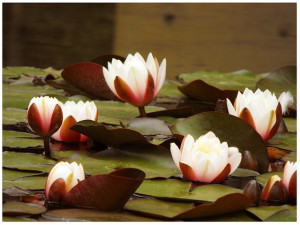
The Lotus Plant (Nelumbo nucifera) is an aquatic plant in the Nelumbonaceae family, and is the national flower of India and Vietnam. Image by alterna used under Creative Commons 2.0.
The lotus plant (Nelumbo nucifera) is considered sacred in the Buddhist and Hindu religions, and been used for over 7000 years in Asia as a source of food, herbal remedy and fibers for clothing. In 2013 its genome was sequenced, allowing its phylogenetic history and adaptations for the aquatic environment to be more fully understood. For example, the plant has a number of genes enabling its adaptation to the nutrient poor soils in waterways, altering its novel root growth, iron regulation and phosphate starvation.
Researchers at the University of Adelaide, Australia, showed that the lotus actually has the ability to regulate the temperature of its flowers, maintaining them between 30 and 36 °C even when air temperature dropped below this. Quite how or why it does this is still unknown, but warmer flowers could play a role in attracting cold-blooded insects and increasing their activity once on the flowers to enhance pollination. An alternative explanation could be that warmer temperatures are required for pollen production.
Another fantastic fact about the lotus is seed viability. A 1300 year old lotus fruit found in a dry lakebed in China was successfully germinated, providing an insight into the aging process of fruits and other organisms
Australia Australian Society of Plant Scientists
Acacia pycnantha
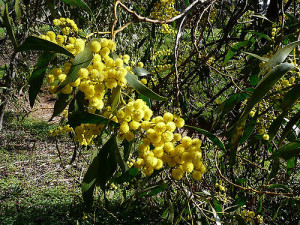
The golden wattle (Acacia pycnantha) is a member of the Fabaceae family. The plant is a small tree that can grow up to 12 meters high! In Australia the 1st September is National Wattle Day. Image by Sydney Oats used under Creative Commons 2.0.
The Australian national flower is the Acacia pycnantha, or wattle, first described in 1942. Its name comes from the Greek pyknos (dense) and anthos (flowers) describing the dense groups of flowers that form on the tree. The wattle is an important source of tannins, and as such has been introduced to parts of southern Europe such as Italy and Portugal in addition to India and New Zealand. The wattle is also found in South Africa where it has now become an invasive pest, and various methods of biological control such as gall forming wasps (Trichilogaster signiventris) are being used to control populations.
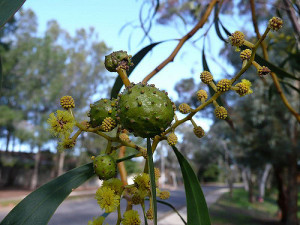
Galls on a wattle tree from T. signiventris. Eggs are laid by the wasp in the buds of flower heads and the hatched larvae induce gall formation which prevents flower development. This in turn prevents pollination and continued propagation of the Wattle population. Image by Sydney Oats used under Creative Commons 2.0.
Japan The Japanese Society of Plant Physiologists
Yellow Chrysanthemum
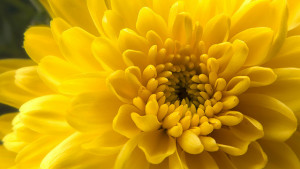
The yellow Chrysanthemum is a member of the Asteraceae family. Species of the Chrysanthemum enus are popular ornamental plants, and as such many hybrids and thousands of cultivars in a variety of colors and shapes can be found. Image by Joe deSousa used under Creative Commons 1.0.
Although cherry blossom is often the flower most associated with Japan, yellow Chrysanthemum flowers are equally as important. The flower is used as the Imperial Seal of Japan and on the cover of Japanese passports. Species of the genus Chrysanthemum are members of the Asteraceae (daisy) family.
Two species of the Chrysanthemum genus, C. cinerariifolium and C. coccineum, synthesize pyrethrum compounds, which attack insect nervous systems. As such these species make good companion plants in the field, repelling insects from economically valuable neighboring plants that do not have their own defense mechanisms. The naturally produced toxins are widely used in organic farming, and many synthetic versions are also available commercially.
South Africa African Crop Science Society
Protea cynaroides
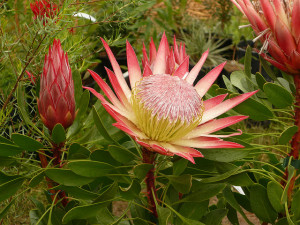
The king protea (Protea cynaroides) is a member of the Proteaceae family and the national flower of South Africa. The South African cricket team has the nickname the Proteas, after the flower. Image by Virginia Manso, used under Creative Commonds 2.0.
The king protea (Protea cynaroides) can grow up to 2 meters in height and comes in several colors and varieties. The plant grows in harsh, dry regions prone to wildfire, and as such has a number of adaptations for the environment. For example, a long tap-root is used for accessing deep water, and tough leathery leaves are resilient to both biotic and abiotic stress. The protea has a thick underground stem with many dormant buds. After a wildfire these dormant buds can become active, forming new stems allowing the plant to survive!
The king protea is only one species within the large Proteaceae family, 120 species of which are now endangered listed on the IUCN Red List of threatened species. The Protea Atlas Project aims to map the geographical location of proteas through Southern Africa in order to help preserve the family. In addition to protea, Southern Africa is home to around 24 000 plant taxa, 80% of which occur no where else in the world. A wider objective of the Protea Atlas Project is to map species-richness patterns in Southern Africa. The distribution of Protea plants within the region largely seems to match the species-richness patterns of other plant species, and therefore proteas are being used as surrogates for plant diversity. Find out more about the project and get involved here.
Germany and Estonia EUCARPIA, EPSO, FESPB, SPPS
Centaurea cyanus
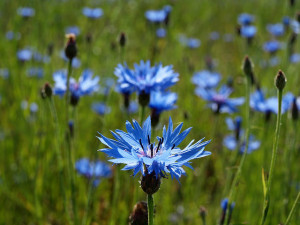
The cornflower (Centaurea cyanus) is a member of the Asteraceae family, like the Chrysanthemum. Image by Anita used under Creative Commons 2.0.
We have a large number of European and Scandinavian member groups, and choosing one flower to represent all of those was a challenge. However, the humble Cornflower seemed an appropriate choice to represent our European societies. This member of the daisy family is not only the national flower of Germany and Estonia, but has a place in many Scandinavian cultures being the symbol for a number of political parties in Finland and Sweden.
In the past this beautiful flower was regarded as a weed, but now due to intensive agricultural practices has become endangered. Cornflowers have many uses in addition to being an ornamental plant. The plant is used in many blends of herbal tea, flowers are edible in salads, and the blue coloring can be used as a clothes dye.
Canada Canadian Society of Plant Biologists
Acer
Although not technically a flower, the leaf of the maple tree is such an iconic symbol on the Canadian flag we just had to include it (we are the Global Plant Council after all). There are many species of maple tree in the genus Acer, which can be distinguished from other genus of trees by their distinctive leaf shape. The most important species of maple in Canada is probably Acer saccharum, the sugar maple. The sap of this species is the major source of maple syrup, and its hard wood is popular for use in flooring and furniture.

Acer saccharum, the sugar maple, in Autumn. Image by Mark K. used under Creative Commons 2.0.
The sugar maple grows throughout the USA and Canada, favoring cooler climates and is a very shade tolerant species. Despite this, the sugar maple is now in decline in many regions. It is highly susceptible to increased levels of air pollution and changes to salt levels. As such the species is now being replaced in many regions by the hardier Norway Maple.
Argentina Argentinian Society of Plant Physiology
Erythrina crista-galli
E. crista-galli, the cockspur coral tree, is the national tree in Argentina. Also known in Argentina as the ceibo, the bright red flower of this tree is also the national flower of Argentina and Uruguay.
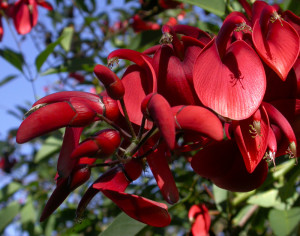
The bright red flowers of E.crista-galli are the national flowers of Argentina and Uruguay. Image by Gabriella F.Ruellan used under Creative Commons 2.0.
The small tree is a legume from the family Fabaceae. Characteristically of species from this family, the fruit of the cockspur coral tree are dry pods, and the roots have nodules containing nitrogen fixing bacteria making them important for increasing the available nitrogen in the soil. Although native to South America, the tree is also naturalized in Australia, where it is becoming an emerging environmental weed. The tree is invading waterways and wetlands displacing native species, and its spread is now being controlled in New South Wales.
If your country has a particularly interesting national flower that we have missed let us know! Perhaps we can include it in a future blog post.

Bahunia is the national flower of Hong Kong, GigaScience is launching a crowdfunding campaign to learn more about the biological and genetic history of this flower.
By Scott Edmunds, Executive Editor, GigaScience Journal
‘Big Data’ is becoming increasingly ubiquitous in our lives, and we at GigaScience are big fans of approaches democratizing its utility through crowdfunding and crowdsourcing. With much mistrust and fear of genetic technologies there is also a huge need to educate and throw light on “what goes on under the hood” during the process of genomic sequencing and research.
After helping promote community genome and microbiome projects such as the Puerto Rican “peoples parrot”, Azolla Genome, Kittybiome, and the community cactus (previously highlighted in the Global Plant Council Blog), the team at GigaScience has finally decided to launch our own.
Inspired by our Hong Kong home, this month we’ve launched an exciting new crowdfunding project to help learn about the enigmatic biological and genetic history of the beautiful symbol of Hong Kong: the Bauhinia flower.
Hong Kong’s emblem is the beautiful flower of the Hong Kong Orchid Tree Bauhinia x blakeana: it is mysterious in origin, and lovely along the roadside and in any garden. Being used as a food crop in India and Nepal, Bauhinias are actually a legume rather than an orchid, and while a transcriptome has been sequenced as part of the 1KP project (Bauhinia tomentosa) no species of the genus has yet had its genome sequenced.
A Brief History of Bauhinia blakeana
It was first discovered in the 1880’s by the famous horticulturist Father Jean-Marie Delavey
growing on a remote mountainside in Hong Kong, but how it got there is a mystery – especially since it is sterile. The missionary collector subsequently propagated it in the grounds of the nearby Pokfulam Sanatorium, and from there it was introduced to the Hong Kong Botanic Gardens and across the world. Originally described as a new species in 1908, it was subsequently named after the Hong Kong governor Sir Henry Blake, who had a strong interest in botany. We have an opportunity to get a glimpse into this fascinating history by carrying out a crowdfunding project to determine its entire genetic make up.
In addition, it’s a project we are trying to get everyone involved in: from gardeners to botanists, historians to photographers, university researchers to school children – really, anyone interested in being a part of Hong Kong’s First Emblematic Genome Project and understanding the biological secrets of this unique flower.
Plant Genomics for the Masses
Teaming up with BGI Hong Kong and scientists at the Chinese University of Hong Kong, this new crowdfunding project will use one of the best techniques to help uncover the secrets of any living being: genomic sequencing. While the cost of sequencing has crashed a million fold since the human genome project, plant genomes are still challenging. While Bauhinia have a relatively small genome (0.6C), being a hybrid means it will be very challenging to assemble using current short-read technologies. To get around this we are having to sequence the two likely parents first, pushing the reagent costs that we need to cover through crowdfunding up to about $10,000. Studies using individual genetic markers have shown that the species is likely a hybrid of two local species, Bauhinia variegata and Bauhinia purpurea, but this has yet to be confirmed at a genomic scale.
Genome sequencing is also one of the key technologies defining the 21st century, and a field in which Hong Kong has made major advances (for example in BGI Hong Kong’s giant sequencing capacity, as well circulating DNA diagnostics), though more effort is needed to engage and inform the general public.
Through sequencing the genome of our emblem to better understand where it came from; this will help to train local students to assemble and analyze the data – crucial skills needed for this field to advance; and engage and educate the public through local pride. Outreach and awareness-building is key, and we have already managed to get plant genomics and Bauhinia onto the front cover of the SCMP Sunday Magazine and on Hong Kong radio.
You can also access the YouKu version of the above video here.
Get involved!
The project seeks a variety of things from the community: at its most basic level, help in the form of donations can be provided at the project’s website. As a community project no contribution is too small, so please contribute via the crowdfunding page.
Furthermore, we’ll be carrying out community engagement and citizen science in the form of Bauhinia Watch, where people in the community can inform researchers about sightings of the flower and its relatives, and look for the hypothesized very rare individual plants that may produce seeds. Photographs along with location information are especially desired, and can be shared with the global community on social media (use the #BauhiniaWatch hashtag).
Also, getting involved in educating the community is key. The project’s website, in addition to explaining the science behind the project, provides information for identifying the different Bauhinia species, which can be fun for curiosity driven individuals of any age. Now is the time! Bauhinia blakeana is in peak flowering season in Hong Kong from November to March.
Moreover, this is a great opportunity for creating school projects, to learn about botany, evolution, the latest scientific technologies, and to participate in the research or carry out fundraising to join the Bauhinia community.
This will be the first Hong Kong genome project: funded by the public; sequenced in Hong Kong; assembled and analyzed by local students; and directly shared with the community.
Being Open Data advocates, all data produced will immediately be shared with our GigaDB platform, and all methods, analyses and teaching materials will be captured and made open to empower others to carry out similar efforts around the world.
Bauhinia Genome welcomes contributions and interest from across the globe, hoping this serves as a model to inspire and inform other national genome projects, and aid the development of crucial genomic literacy and skills across the globe; inspiring and training a new generation of scientists to use these tools to tackle the biggest threats to mankind: climate change, disease and food security. We have already collected enough money to fund the transcriptome, and the next goal is to get enough funds to start sequencing the genomes of the family members. To enable us to do this support us through our crowdfunding site, like us on Facebook or twitter, and help spread the word.
For more information and to support the project visit the website and crowdfunding page. follow us on Twitter @BauhiniaGenome, or on Facebook, and include the hashtag #BauhiniaWatch for any news or pictures you’d like to share on social media.